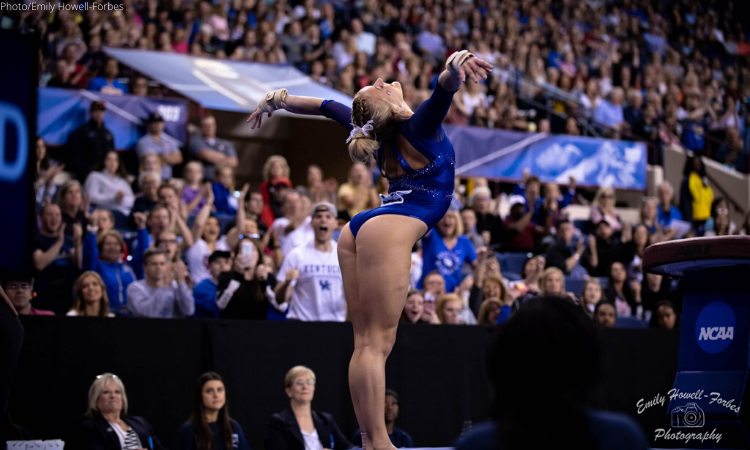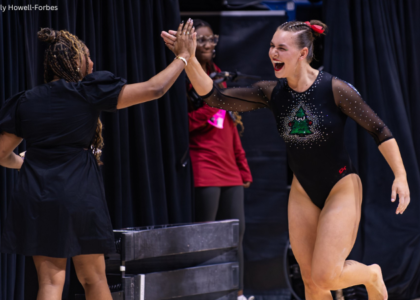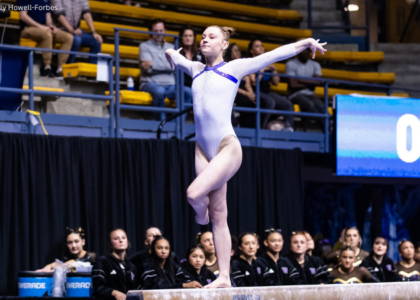The 2020 postseason is right around the corner. We all know that gymnastics can be a little confusing (OK, a lot confusing), so we thought we’d break down some of the most common questions we see being asked about RQS, nationals and everything in between.
Don’t see your burning question here? Ask it in the comments or on social media, and we’ll be sure to answer.
What is the postseason format?
While many consider conference championships to be a part of the postseason, it officially starts with regionals. Thirty-six teams qualify to regionals, which consists of three rounds. The first round is a play-in where two teams go head to head to advance to round two. Round two features seven teams plus the winner of the play-in, split into two sessions. The top two teams from each session qualify to the regional final where two teams from that meet qualify to nationals. There are four regionals, meaning eight teams qualify to compete at nationals, which features two semifinal sessions on day one and a four-team final to close out the season.
What are USAG and NCGA national championships? Can those teams/individuals still qualify to regionals?
Teams with less than seven and a half scholarships are eligible to compete at USAG nationals. That includes all DII, Ivy League and service academy schools plus DIII Centenary and a handful of DI teams that do not field 12 full scholarships for the program. But note that Penn has decided not to contend for USAG nationals in 2020. The top eight teams ranked by RQS qualify full squads to USAG nationals.
NCGA nationals, also referred to as DIII nationals because all DIII teams with the exception of Centenary are eligible to compete. The top three teams from each of the two DIII regional/conference competitions, the NCGA-East championship and the NCGA-West or WIAC championship, qualify full teams to NCGA nationals.
All 81 teams are eligible to compete at regionals, including USAG and NCGA teams. DII Lindenwood qualified a full team to regionals last year, and many DIII individuals have competed there in the past.
How is RQS calculated?
To calculate RQS, or regional qualifying score, add the team’s top six scores—three of which must be from away meets—remove the high score and average the remaining five.
What is the difference between RQS and NQS?
Literally, RQS is regional qualifying score and NQS is national qualifying score. Prior to the 2019 season, RQS was calculated (see above) to determine rankings for qualification to regionals while NQS was used to determine seeding at nationals by adding a team’s RQS to its regional competition score.
However, in 2019 things changed so RQS was essentially gotten rid of and instead referred to as NQS.
But wait! It appears as if in 2020, we’re going back to calling it RQS and getting rid of NQS—because seeding for nationals is done prior to regionals to fit the new bracket model vs. using scores from regionals to seed teams into the two nationals semifinals.
Why not just use average score?
Because the college gymnastics season is so long—some teams compete a whopping 13 regular season meets—RQS is used to help eliminate anomalies, bad meets, slow starts, instances where a big chunk of a team is hit with the flu, etc. that can affect teams’ averages. It allows teams to drop bad scores, as well as account for especially crack judging by dropping the highest scores as well.
For a good example in favor of using RQS or something like it, look at Arizona’s meet two years ago when it suspended half the team and only put up a score in the 140s. Having to average in an incomplete meet like that would ruin any team’s chance at making the postseason.
Some may argue that RQS isn’t the best way to determine rankings, but it does help show a better picture of teams’ true strengths than ranking by average.
How do individuals qualify to regionals?
First, determine the top 28 teams in the RQS rankings and take out individuals on all those teams from the individual RQS rankings. Once those gymnasts on qualifying teams are removed, the top 12 all arounders and top 16 event specialists (by RQS) on each event qualify to compete during round two of regionals for a chance at qualifying to nationals. These individuals include gymnasts from the eight play-in teams so as to account for gymnasts on the round one losing team to still have a chance at qualifying to nationals.
Why can some gymnasts from teams who qualified to regionals also qualify as individuals? How do individuals qualify to nationals?
Gymnasts on the eight play-in teams, as stated above, are included in the qualified individuals at regionals to ensure they still have a chance at qualifying to nationals even if their team loses in round one. Still confused? The individual qualification to nationals happens during round two of regionals. So to have a chance to compete at nationals, you have to compete during one of the round two sessions. If a team is eliminated in round one, any eligible individuals would not have that round two opportunity, meaning the designated individuals have to be given the opportunity in advance should their team not win the play-in.
So we know that individuals compete during round two to qualify to nationals, but how exactly do they move on to compete there? After both round two regionals sessions conclude, combine the individual all around and event results. Then, wait until round three concludes to see which two teams advance. Then scratch out the names on the individual results of the gymnasts on a nationals qualifying team. The top all arounder and top gymnasts on each event from each regional move onto nationals, resulting in a total of four all arounders and four individuals on each event getting the opportunity to compete at nationals. For tie break rules, check out our postseason explainer article.
Article by Elizabeth Grimsley
Like what you see? Consider donating to support our efforts throughout the year!





3 comments